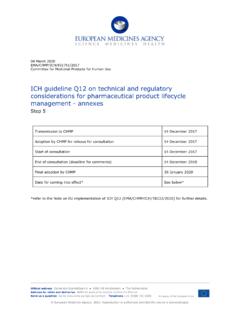Transcription of Material Safety Data Sheet for cement - PPC Ltd
1 Material Safety DataSheet for cementMSDS1. product IdentificationManufacturer:PPC Katherine Street (Cnr Grayston Drive)SandtonPPC (telephone): 011 386 9000 PPC Helpline: 0800 023 470 Poison Information Centres: 011 495 5112 / 021 931 6129 / 021 689 5227 (all hours)(i) Trade name :OPC, SureBuild, SureRoad, UniCem, BotCem.(ii) Chemical family :020 Calcium compounds014 Silicates026 Iron compounds (ferrites)013 Aluminum compounds (aluminates)(iii) Chemical name :Portland cement (iv) Synonyms : cement , Portland cement , Portland-composite ce-ment, Blastfurnace cement , pozzolanic cement and Composite cement .(v) Chemical abstract number :65997-15-1(vi) NIOSH number :-(vii) RTECS number :W8770000(viii) UN number :Awaited2. CompositionMain constituents are calcium silicates, aluminates, ferro-aluminates and sulfates. It contains gypsum and small amounts of sodium, potassium and chromium silicate 55-70% CAS # 12168-85-3 Dicalcium silicate 5-20% CAS # 1003-77-2 Tricalcium aluminate 2-10% CAS # 12042-78-3 Tetra calcium aluminoferrite 5-15% CAS # 12068-35-8 Gypsum 2-5% CAS # 13397-24-5 Calcium oxide CaO < CAS # 1305-78-8 Extenders that are inter-ground with Portland cement clinker and gypsum are indicated by the standard desig-nation.
2 They are defined as: L Limestone S Slag V Siliceous fly ash3. Hazard identificationHazard Classification Irritantii) Hazard ID - Rating .. (a) Health Rating : 1 - Slight (b) Flammability : 0 - None (c) Instability: 2 - Moderate (d) Contact Rating: 2 - Moderate(iii) Personal Protective Equipment: Wear gloves and long sleeves(iv) Overview: cement dust acts as a skin and respiratory irritant. Dust and wet cement act as a serious eye irritant. Long term exposure may lead to contact dermatitis. 4. First Aid MeasuresProduct in Eye: Wash eyes with large volumes of water. Seek medical attention. The fornices (behind the eyelids) should always be checked for congealed Ingestion: Ingestion in a harmful quantity is very unlikely to occur.
3 If ingested drink plenty of water and consult a doctor immediately. DO NOT INDUCE Inhaled: Remove exposed person to fresh air. Prolonged exposure at high dust concentrations may cause a cough and on Skin: Wash with water and to Medical Practitioner: Fire Fighting MeasuresThis product is not combustible, use agent most appropriate to extinguish surrounding Accidental Release MeasuresPersonal precautions Dust mask where TLV is exceeded. Wear eye shielding. Any type of glove which prevents contact with the productEnvironmental precautionsNon toxic in small quantities. Large quantities in water will lead to high pH values, up to life will be endangered. The cement will harden, possibly forming a crust. It may dissolve slowly in acid conditions(i) Small spills(a) Containment Sweep up. Prevent dust becoming airborne(b) Clean-up Sweep up. Prevent dust becoming airborne(ii) Large spills(a) Containment Sweep up.
4 Prevent dust becoming airborne(b) Clean-up Sweep up. Prevent dust becoming airborne 7. Handling / StorageDuring handling aerated cement has liquid properties which disperse after Colour Code : OrangeSuitable Material Paper or plastic bags. Silos, bins8. Exposure controls/ Personal ProtectionOccupational exposure limits TWA OEL RL 5mg/m3 respirable dust, 10mg/m3 total inhalable protection Dust mask, Safety glasses or goggles, gloves9. Physical and Chemical propertiesPhysical PropertiesFine grey to white powder . Particle size < density to g/mlMelting point > 1500 CAlkalinity can exceed pH of 12 in PropertiesNo hazardous decomposition products10. Stability and ReactivityStable, but product will solidify over a period of hours if moistened or wet. Absorbs moisture from the air and solidifies over prolonged periods if not kept in a protected dry Toxicological informationDust acts as a skin and respiratory irritant.
5 Dust and wet cement cause serious eye irritation. Long term exposure may lead to contact dermatitis12. Ecological informationNon toxic in small quantities. Large quantities in water will lead to high pH values, up Aquatic life will be endangered. The cement will harden, possibly forming a crust. It may dissolve slowly in acid Disposal considerationsWhatever cannot be saved for recovery or recycling should be managed in an appropriate and approved waste facility. Although not a listed RCRA hazardous waste, this Material may exhibit one or more characteristics of a hazardous waste and require appropriate analysis to determine specific disposal requirements. Processing, use or contamination of this product may change the waste management options. Dispose of container and unused contents in accordance with local Transport InformationIn terms of the National Road Traffic Act, act 93 of 1996 regulations and SANS 10228 (The identifica-tion and classification of dangerous goods for transport by road and rail modes), Portland cement and cement blends are not terms of the International Maritime Dangerous Goods Code, Portland cement and cement blends are not hazardous and as such do not have a number.
6 Portland cement is listed as an Appendix C cargo in terms of the BC code. 15. Regulatory informationNot regulated16. Other informationRisk phrases R36 R37, R38 Safety phrases S24, S25, S26, S36, S37, S39 R36 Irritating to eyes. R37 Irritating to respiratory system. R38 Irritating to skin. S24 Avoid contact with skin. S25 Avoid contact with eyes. S26 In case of contact with eyes, rinse immediately with plenty of water and seek medical advice. S36 Wear suitable protective clothing. S37 Wear suitable gloves. S39 Wear eye/face sourceAuthor and / or Contact details: Refer to section Source of MSDS: The Physical and Theoretical Chemistry Laboratory Oxford University Chemical and Other Safety Information. # & SACPAI nformation contained in this Material Safety Data Sheet is accurate at the date of publication. The company does not accept liability for any injury, illness, loss or misinterpretation arising from the use of this 2016


